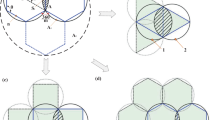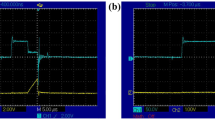Abstract
Electrical discharge machining (EDM) is extensively used for machining difficult-to-machine materials and complicated shapes. Its performance in terms of material removal rate and surface roughness is usually analyzed using the process parameters such as setting voltage, setting current, pulse on time, and duty factor. It is well known that interelectrode gap condition controls the EDM performance, and it is difficult to observe the gap phenomena directly. Literature reveals that the combined influence of pulse types and their individual contributions on material removal rate and surface roughness has been ignored. In the present work, rough and finish EDM conditions are identified from a large set of 125 experiments carried out on hardened D3 die steel. From the voltage and current pulse trains in each regime, pulse characteristics and five different pulse types are assessed by a unique thresholding approach. Based on the pulse details, two new parameters such as energy expended (E) at the electrode gap over a second and a performance factor (PF) giving ratio of energy associated with the sparks to total energy expended have been proposed. It is found that a higher PF of 0.757 at a relatively lower expended energy of 113.7 J leads to a favorable condition in rough machining. A relatively lower E of 29.7 J and a higher PF of 1.00 are favorable for finish machining. Cross-sectional images of the ED machined workpieces are also included as evidences. The proposed thresholding methodology has a potential for online monitoring, analysis, and control of EDM process.
Similar content being viewed by others
References
Abbas NM, Solomon DG, Bahari MF (2007) A review on current research trends in electrical discharge machining EDM. Int J Mach Tools Manuf 47(7–8):1214–1228. https://doi.org/10.1016/j.ijmachtools.2006.08.026
Assarzadeh S, Ghoreishi M (2017) Electro˗thermal˗based finite element simulation and experimental validation of material removal in static gap single˗spark die˗sinking electro˗discharge machining process. Proc IMechE, Pt B: J Eng Manuf 231(1):28–47. https://doi.org/10.1177/0954405415572661
Chen Y, Mahdivian SM (2000) Analysis of electro˗discharge machining process and its comparison with experiments. J Mater Process Technol 104(1–2):150–157. https://doi.org/10.1016/S0924-0136(00)00531-8
Çoğun C (1990) A technique and its application for evaluation of material removal contributions of pulses in electrical discharge machining (EDM). Int J Mach Tools Manuf 30(1):19–31. https://doi.org/10.1016/0890-6955(90)90038-K
Crookall JR (1973) A basic analysis of pulse trains in electro˗discharge machining. Int J Mach Tool Des Res 13(3):199–213. https://doi.org/10.1016/0020-7357(73)90014-0
DiBitonto DD, Eubank PT, Patel MR, Barrufet MA (1989) Theoretical models of the electrical discharge machining process. I. A simple cathode erosion model. J Appl Phys 66(9):4095–4103. https://doi.org/10.1063/1.343994
Eubank PT, Patel MR, Barrufet MA, Bozkurt B (1993) Theoretical models of the electrical discharge machining process. III. The variable mass, cylindrical plasma model. J Appl Phys 73(11):7900–7909. https://doi.org/10.1063/1.353942
Gangadhar A, Shunmugam MS, Philip PK (1992) Pulse train studies in EDM with controlled pulse relaxation. Int J Mach Tools Manuf 32(5):651–657. https://doi.org/10.1016/0890-6955(92)90020-H
Ginzel J, Behrens A, Wulfsberg JP (2004) Technology development for EDM using statistical analysis of arcing information. J Mater Process Technol 149(103):232–237. https://doi.org/10.1016/j.jmatprotec.2003.10.039
Hinduja S, Kunieda M (2013) Modelling of ECM and EDM processes. CIRP Ann Manuf Technol 62(2):775–797. https://doi.org/10.1016/j.cirp.2013.05.011
Ho KH, Newman ST (2003) State of the art electrical discharge machining (EDM). Int J Mach Tools Manuf 43(13):1287–1300. https://doi.org/10.1016/S0890-6955(03)00162-7
Jilani ST, Pandey PC (1983) An analysis of surface erosion in electrical discharge machining. J Wear 84(3):275–284. https://doi.org/10.1016/0043-1648(83)90269-7
Joshi SN, Pande SS (2010) Thermo˗physical modeling of die˗sinking EDM process. J Manufact Process 12(1):45–56. https://doi.org/10.1016/j.jmapro.2010.02.001
Keskin Y, Halkacı HS, Kizil M (2006) An experimental study for determination of the effects of machining parameters on surface roughness in electrical discharge machining (EDM). Int J Adv Manuf Technol 28(11-12):1118–1121. https://doi.org/10.1007/s00170-004-2478-8
Koenig W, Wertheim R, Zvirin Y, Toren M (1975) Material removal and energy distribution in electrical discharge machining. Ann CIRP 24(1):95–100
Kunieda M, Lauwers B, Rajurkar KP, Schumacher BM (2005) Advancing EDM through fundamental insight into the process. CIPR Ann 54(2):64–87. https://doi.org/10.1016/S0007-8506(07)60020-1
MatLab R10a, MathWorks, Inc., 2010
Nowicki B, Dmowska A, Podolak-Lejtas A (2011) A new method of investigating crater and flash made by individual discharge using scanning profilometers. J Wear 270(3):121–126. https://doi.org/10.1016/j.wear.2010.03.031
Patel MA, Barrufet MA, Eubank PT, DiBitonto DD (1989) Theoretical models of the electrical discharge machining process. II. The anode erosion model. J Appl Phys 66(9):4104–4111. https://doi.org/10.1063/1.343995
Rajurkar KP, Wang WM, Lindsay RP (1990) Real˗time stochastic model and control of EDM. Ann CIRP 39(1):187–190. https://doi.org/10.1016/S0007-8506(07)61032-4
Salonitis K, Stournaras A, Stavropoulos P, Chryssolouris G (2009) Thermal modeling of the material removal rate and surface roughness for die-sinking EDM. Int J Adv Manuf Technol 40(3–4):316–323. https://doi.org/10.1007/s00170-007-1327-y
Shabgard MR, Gholipoor A, Baseri H (2016) A review on recent developments in machining methods based on electrical discharge phenomena. Int J Adv Manuf Technol 87(5–8):2081–2097. https://doi.org/10.1007/s00170-016-8554-z
Singh A, Ghosh A (1999) A thermo˗electric model of material removal during electric discharge machining. Int J Mach Tools Manuf 39(4):669–682. https://doi.org/10.1016/S0890-6955(98)00047-9
Snoeys R, Cornelissen H (1975) Correlation between electro˗discharge machining data and machine settings. Ann CIRP 24(1):83–88
Snoeys R, Dauw D, Kruth JP (1983) Survey of adaptive control in electro discharge machining. J Manuf Syst 2(2):147–164. https://doi.org/10.1016/S0278-6125(83)80028-4
Stavropoulos P, Chantzis D, Doukas C, Papacharalampopoulos A, Chryssolouris G (2013) Monitoring and control of manufacturing processes: a review. Procedia CIRP, 14th CIRP Conference on Modelling of Machining Operations (CIRP CMMO), 13–14 June, Turin, Italy. doi: https://doi.org/10.1016/j.procir.2013.06.127
Takezawa H, Kokubo H, Mohri N, Horio K (2008) A study on single discharge machining with low melting temperature alloy(1st report)˗The relationship between removal volume of crater and single discharge conditions. J JpN Soc Electr Mach Eng 42:5–11
Tarng TS, Tseng CM, Chung LK (1997) A fuzzy pulse discriminating system for electrical discharge machining. Int J Mach Tools Manuf 37(4):511–522. https://doi.org/10.1016/S0890-6955(96)00033-8
Valentinčič J, Junkar M (2004) A model for detection of the eroding surface based on discharge parameters. Int J Mach Tools Manuf 44(2–3):175–181. https://doi.org/10.1016/j.ijmachtools.2003.10.013
Wang WM, Rajurkar KP (1992) Modeling and adaptive control of EDM systems. J Manuf Systems 11(5):334–345. https://doi.org/10.1016/0278-6125(92)90062-K
Wong YS, Edkins M, Noble CF (1987) An investigation of the power output and gap voltage during electrical discharge machining using microcomputer˗based instrumentation. Int J Mach Tools Manuf 27(2):191–214. https://doi.org/10.1016/s0890-6955(87)80050-0
Yu SF, Lee BY, Lin WS (2001) Waveform monitoring of electric discharge machining by wavelet transform. Int J Adv Manuf Technol 17(5):339–343. https://doi.org/10.1007/s001700170168
Acknowledgements
The authors are thankful to DST (Grant No. SR/S3/MERC˗68/2004 dated 08˗06˗2007) and IIT Madras (Grant No. MEE/03˗04/181/IDRP/OVKC dated 01˗10˗2003) for providing the measurement facilities, at the Manufacturing Engineering Section, necessary to carry out the present investigation.
Author information
Authors and Affiliations
Corresponding author
Rights and permissions
About this article
Cite this article
Rajeswari, R., Shunmugam, M.S. Investigations into process mechanics of rough and finish die sinking EDM using pulse train analysis. Int J Adv Manuf Technol 100, 1945–1964 (2019). https://doi.org/10.1007/s00170-018-2701-7
Received:
Accepted:
Published:
Issue Date:
DOI: https://doi.org/10.1007/s00170-018-2701-7




